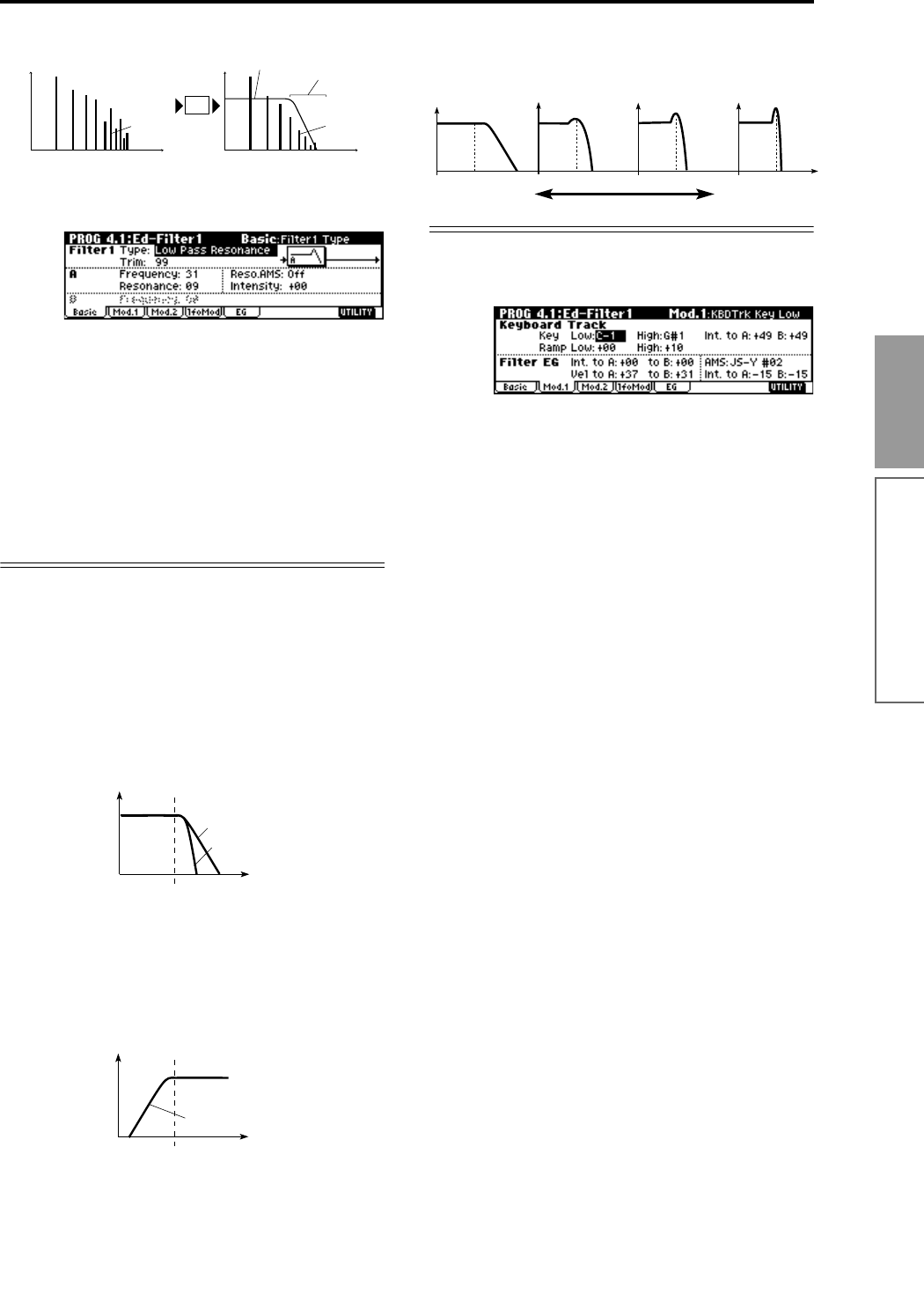
53
Basic functions
Program mode
Basic page
Filter Type, Filter A, Filter B
Selects the type of filter, and specify the “Frequency”
(cutoff frequency) and “Resonance” (resonance level).
• Low Pass Resonance (24 dB/oct low pass filter
with resonance): Make settings for filter A.
• Low Pass & High Pass (12 dB/oct low pass filter
and 12 dB/oct high pass filter in series connection):
Make low pass filter settings in filter A, and high
pass filter settings in filter B.
Low pass filter
This is the most common type of filter, which passes
the low frequency range and cuts the high frequency
range. When the overtones of the high range are cut, a
bright sound will become darker (more mellow).
24 dB/oct and 12 dB/oct refer to the steepness of the
cut. 24 dB/oct means that the gain will decrease 24 dB
in one octave (i.e., as the frequency doubles). A 12 dB/
oct filter would decrease the gain 12 dB in one octave.
The 24 dB/oct filter produces a steeper cut.
High pass filter
This type of filter passes the high frequency range and
cuts the low frequency range. Use this when you wish
to make the sound thinner. However if the cutoff fre-
quency (Frequency) is raised excessively high, the vol-
ume will become very low.
Resonance
When “Resonance” is set to a higher value, the over-
tones in the region of the cutoff frequency will be
boosted as shown in the diagram below, giving a dis-
tinctive character to the sound.
Mod.1, Mod.2 page
Controllers and the filter EG can be used to modulate
the filter cutoff frequency that was specified in the
Basic page. By using a controller to vary the tone or by
using an EG to create time-varying changes, you can
add a rich variety of tonal change to the sound.
Keyboard Track (Mod.1 page)
This varies the cutoff frequency according to the posi-
tion of the key on the keyboard that you play.
• When Ramp “Low” is set to a positive (+) value,
the cutoff frequency will rise as you play lower on
the keyboard, making the sound brighter. When set
to a negative (–) value, the cutoff frequency will fall
as you play lower on the keyboard, making the
sound darker.
• When Ramp “High” is set to a positive (+) value,
the cutoff frequency will rise as you play higher on
the keyboard, making the sound brighter. When set
to a negative (–) value, the cutoff frequency will fall
as you play higher on the keyboard, making the
sound darker.
• Int. “to A” and “to B” adjust the effect that
keyboard tracking will have on filters A and B
(
☞PG p.14).
Filter EG (Mod.1 page)
Adjusts the effect produced by the filter EG, whose set-
tings are made in the EG page.
• Use the Int. “to A” and “to B” settings to specify
the depth of the filter EG.
• Use the Vel “to A” and “to B” settings to specify
the effect of velocity on the filter EG.
•“AMS” and “Int to A, B” adjust the effect that AMS
will have on the filter EG depth.
These three settings will determine the depth of the
tonal change produced by the filter EG.
Filter Modulation (Mod.2 page)
Set this when you wish to produce tonal change by
using controllers etc. to vary the cutoff frequency.
lfoMod (LFO Mod.) page
Indicates settings that allow the LFO to produce cyclic
changes in tone (a “wah” effect).
Level
Frequency (pitch)
Overtones included
in the original multisample
Level
Frequency (pitch)
Filter characteristics
Overtones after
passing through
the filter
This area of
overtones will
be diminished
Filter
Frequency
Level
Low Pass
12dB/oct
24dB/oct
High Pass
12dB/oct
Frequency
Level
When resonance is applied
Low Pass
Level
Low resonance value High resonance value


















